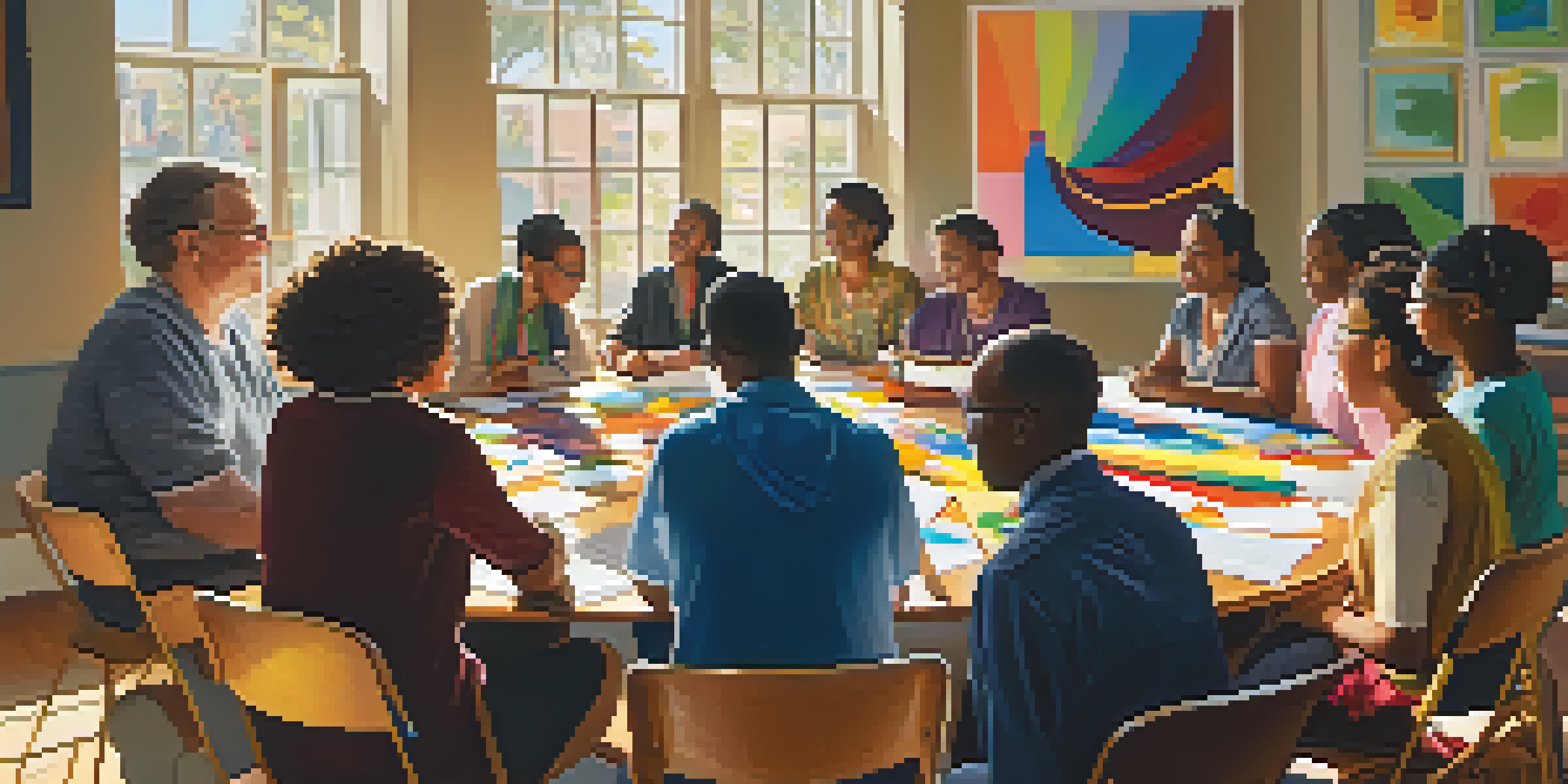Integrating Cultural Competence in Teacher Learning Groups

Understanding Cultural Competence in Education
Cultural competence refers to the ability to understand, communicate with, and effectively interact with people across cultures. In the context of education, it means recognizing the diverse backgrounds of students and adapting teaching methods accordingly. This understanding not only fosters a more inclusive environment but also enhances student engagement and learning outcomes.
Cultural competence is not just a skill; it is a lifelong journey of understanding and valuing diversity.
In recent years, the educational landscape has become increasingly diverse, making cultural competence essential for teachers. By embracing this concept, educators can create learning experiences that respect and value students' individual identities. Think of it as tuning into a different radio station; when teachers adjust their frequency to understand their students better, they can facilitate deeper connections and learning.
Moreover, cultural competence is not just a one-time training session; it’s an ongoing journey. Teachers should continuously seek to educate themselves about the cultures represented in their classrooms, ensuring they remain responsive to the evolving needs of their students. This commitment enriches the educational experience for both teachers and students alike.
The Role of Teacher Learning Groups
Teacher learning groups are collaborative spaces where educators can share insights, strategies, and experiences. These groups provide a supportive network that encourages professional growth and fosters a sense of community among teachers. By integrating cultural competence into these interactions, teachers can collectively enhance their skills and understanding of diverse student needs.

In these learning groups, teachers can discuss their challenges and successes in addressing cultural diversity in their classrooms. For instance, if one teacher shares a strategy that worked well with a specific cultural group, others can adapt and apply it to their own practices. This sharing of resources not only builds camaraderie but also equips educators with a broader toolkit for teaching effectively.
Cultural Competence Enhances Education
Understanding and adapting to diverse student backgrounds fosters inclusivity and improves learning outcomes.
Additionally, these groups can serve as a platform for ongoing cultural training. By inviting guest speakers from various cultural backgrounds or organizing workshops focused on cultural issues, teachers can expand their knowledge and perspectives. This collaborative approach helps to ensure that cultural competence becomes a shared priority among all educators involved.
Strategies for Integrating Cultural Competence
Integrating cultural competence into teacher learning groups requires intentional strategies. One effective approach is to establish ground rules that emphasize respect and openness during discussions. By creating a safe space for sharing experiences, teachers can engage in meaningful dialogues that promote understanding of cultural differences and similarities.
The more we learn about others, the more we understand ourselves.
Another strategy is to incorporate diverse resources and materials into group discussions. Educators can share articles, case studies, and videos that highlight different cultural perspectives. This exposure not only enriches the conversation but also helps teachers recognize the breadth of experiences that their students bring to the classroom.
Furthermore, it's crucial to encourage reflection within these groups. By prompting teachers to think critically about their own biases and cultural assumptions, they can become more aware of how these factors influence their teaching. This self-awareness is a vital step toward fostering a truly inclusive educational environment.
Creating a Safe Space for Dialogue
A critical aspect of integrating cultural competence is establishing a safe space for open dialogue. Teachers must feel comfortable discussing their experiences and challenges related to cultural differences. This environment encourages vulnerability and honesty, allowing educators to learn from one another without fear of judgment.
To create this safe space, facilitators can set the tone by modeling respectful communication and active listening. When teachers see their peers sharing openly, they’re more likely to follow suit. This collective honesty promotes trust among group members and enhances the overall learning experience.
Collaborative Learning Supports Growth
Teacher learning groups encourage sharing strategies and experiences, enhancing cultural competence among educators.
Additionally, using icebreakers or team-building activities can help to establish rapport within the group. By participating in light-hearted, culturally themed games or discussions, teachers can break down barriers and build connections that will facilitate deeper conversations in the future.
Leveraging Diverse Perspectives
Diversity in teacher learning groups can significantly enhance the discussion around cultural competence. When educators from various backgrounds come together, they bring unique insights and experiences that can enrich the group's understanding. This diversity creates a tapestry of perspectives that can lead to innovative teaching strategies.
For example, a teacher who has lived in a different country may share practices that have been effective in their own classrooms. Their experiences can introduce new ideas that others may not have considered, fostering creativity and adaptability in teaching approaches. This exchange of diverse perspectives is invaluable for professional growth.
Moreover, embracing diverse voices can also help educators recognize and challenge their own cultural biases. When teachers learn to appreciate the richness of different cultures, they can better support their students’ diverse needs. This not only enhances their teaching but also contributes to a more equitable educational environment.
Evaluating the Impact of Cultural Competence
To truly understand the effectiveness of integrating cultural competence in teacher learning groups, it’s essential to evaluate its impact. This can involve gathering feedback from participants about their experiences and the changes they’ve observed in their teaching practices. By assessing these outcomes, groups can identify what’s working and what needs improvement.
Additionally, educators can track student engagement and performance to measure the direct effects of culturally competent teaching. For instance, observing whether students feel more connected and motivated can provide valuable insights into the effectiveness of these strategies. This data can help educators refine their approaches and continue to grow.
Ongoing Reflection Promotes Adaptation
Regular evaluation of teaching practices and student engagement ensures continuous improvement in cultural competence.
Regular evaluations also encourage a culture of continuous improvement within the learning group. When teachers see the tangible benefits of their efforts, they are more likely to remain committed to integrating cultural competence into their practice. This ongoing cycle of reflection and adjustment ensures that the group evolves alongside the changing needs of students.
Fostering Lifelong Learning in Educators
Integrating cultural competence into teacher learning groups ultimately fosters a culture of lifelong learning among educators. As teachers engage in ongoing discussions about culture, they develop a mindset that values continuous growth and adaptation. This commitment to learning not only benefits their professional development but also positively impacts their students.
By embracing a lifelong learning approach, educators become more receptive to new ideas and diverse perspectives. They are encouraged to seek out additional training, attend workshops, or even engage with cultural communities outside of school. This proactive stance enhances their cultural competence and enriches the educational experiences they provide.

Ultimately, fostering lifelong learning creates a ripple effect. As teachers grow and evolve, they inspire their students to adopt similar attitudes toward learning and cultural understanding. This shared journey promotes a more inclusive and empathetic classroom environment, where everyone feels valued and respected.